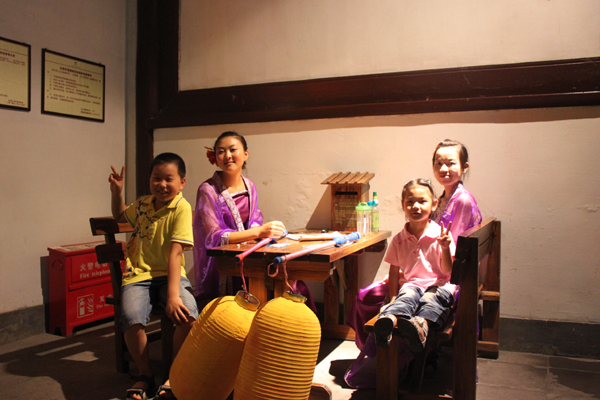Du Fu Thatched Cottage Museum a colored wonderland
Updated: 2011-08-06 22:09
By Huang Zhiling (chinadaily.com.cn)
|
|||||||||||
CHENGU: Visitors to the Du Fu Thatched Cottage Museum in this capital city of Southwest China's Sichuan province, were given a pleasant surprise last night, for the usually tranquil sacred land of Chinese poetry was like a colored wonderland.
 |
|
Women dressed in Tang Dynasty (AD618-907) costume have a strong appeal to visitors who queue up to have photos taken with them. [Photo/Wang Xuejun]? |
Decorated with traditional lanterns and colorful lights, the museum launched a 39-day-long event entitled "Night Trip to the Thatched Cottage" on Friday evening, attracting around 3,000 locals and travellers.
It is the second night trip program launched by the museum, according to Jia Lan, curator of the Du Fu Thatched Cottage Museum, who expects some 100,000 people to visit her museum again this year.
Last year, the museum hosted the first night trip from September 20 to October 20. The event proved a great success, drawing nearly 100,000 visitors.
Like last year, visitors can visit the museum from 6:30 pm to 10 pm by paying a 20 yuan (US$3) entrance fee. They will be able to appreciate traditional Chinese music and dance, puppet shows and sugar painting.
Visitors can also come across women dressed in Tang Dynasty (AD618-907) costumes, and holding lanterns and fans, in the museum every night, which would remind visitors of the old good days.
Located on the banks of the Flower Bathing Brook in western Chengdu, the museum is not a cottage in the literal sense. It is, instead, a commemorative museum including a traditional Chinese garden built at the site where the poet Du Fu (AD712-770) constructed a thatched cottage for his family in AD760.
His poems are an integral part of school textbooks, and any foreign student of Chinese literature should be acquainted with his works.
Du lived during the period that marked the beginning of the decline of the Tang Dynasty. He experienced a war fought by two rebel generals from AD755 to 763, which ravaged many parts of the country and led to the dynasty's decline.
A native of Gongxian county in Central China's Henan province, Du moved to Chengdu in AD759 to escape the war.
The following spring, he built a cottage by the Flower Bathing Brook with the help of a friend. There he lived a peaceful life for about four years, writing 240 of his existing 1,400 poems.
Du is known as the Poetic Saint in the history of Chinese literature. His poems are known for sympathetic portrayals of human suffering and bitterness in the face of injustice and corruption.
Today, the Du Fu Thatched Cottage Museum consists of several structures including a replica of Du's thatched cottage built in 1997, based on descriptions found in his poems.